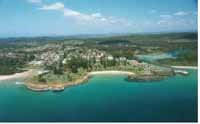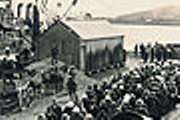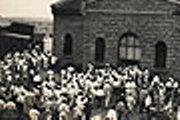 Photo: Zivil Lager, German Internment Camp, Trial Bay, First World War.
Photo: Zivil Lager, German Internment Camp, Trial Bay, First World War.Located on the Mid North Coast (six hours from Sydney by car, seven hours from Brisbane, three hours from Armidale), Trial Bay is one of the most beautiful parts of New England.
Its main centre, South West Rocks, is a small peaceful seaside town that remains a holiday favourite for many New Englanders including my family.

Driving around the area I had seen the ruins of the nearby Trial Bay Goal. I also had a vague memory of a novel written by a New England writer - possibly Gwen Kelly (and here) - about a German POW who had fallen in love with a local girl. I do not know at the moment if Gwen did write the book, this is something I have to check, but given what I have now learned I can see how the plot might have arisen.
I found out about the German connection with Trial Bay by accident through a link on Ninglun's New Lines from a Floating Life blog, a very thoughtful blog that I often visit.
The full story can be found on the NSW Government's Migrant Heritage web site.
The Trial Bay Gaol was established in 1876 as an experimental Public Works Gaol where the inmates would construct the breakwater. Only three years later work was abandoned and the gaol was closed in July 1903. After just 17 years of use, the abandoned gaol remained as testimony to an experiment in humane prison reform.
With the onset of World War 1, the old gaol was given a new lease of life as a German internment camp The outbreak of fighting in Europe in August 1914 immediately brought Australia into the Great War. Within one week of the declaration of war, all German subjects in Australia were declared ‘enemy aliens’ and were required to report to the Government and notify their address.
In February 1915 the meaning of 'enemy aliens' changed to include naturalised migrants as well as Australian born people whose fathers of grandfathers had been born in Germany or Austria. This was a very large group, so in practice internment focused on those considered to be most important.

In August 1915 the first group of Trial Bay internees left Sydney on the North Coast Steam Navigation Company's steamship SS Yulgilbar. The photograph shows them lining up to board the ship.

Conditions at the camp were strict. The associated photograph shows roll call. However, internees also developed a very active and vibrant camp life as a partial relief from their captivity including a newspaper and various cultural activities.
The camp finally closed in July 1918.










No comments:
Post a Comment